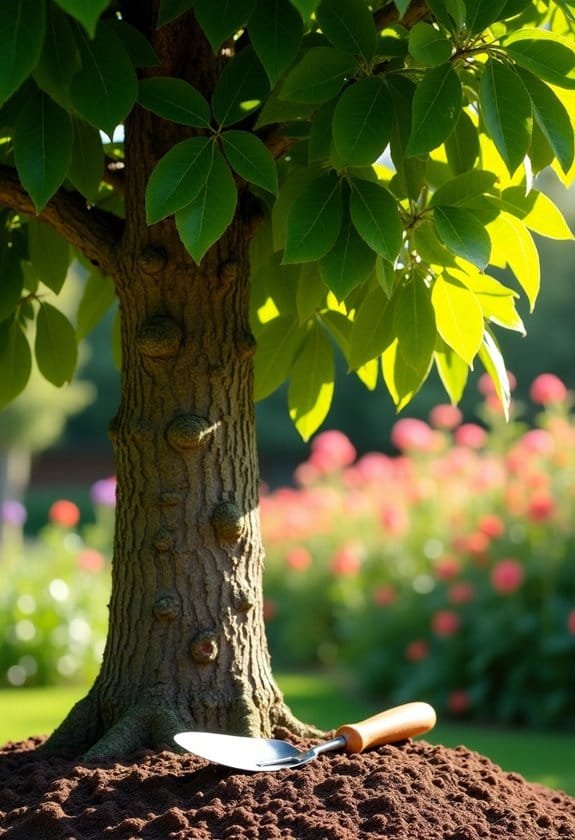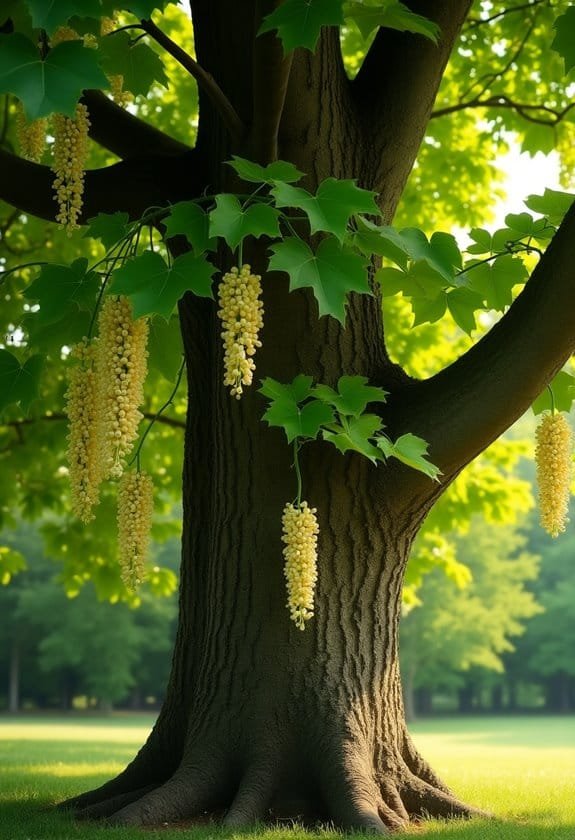Tilia platyphyllos, known as broad-leaved lime, is a magnificent, deciduous tree reaching heights of 60 to 80 feet and boasting a pyramidal shape. Its heart-shaped leaves, measuring 6 to 12 cm, are soft and prominently broad. This species thrives in well-drained, alkaline soils and flourishes under full sun to partial shade, making it well-suited for urban environments. Flowering in late spring to early summer, it attracts crucial pollinators like honeybees and butterflies, enhancing local biodiversity. With careful maintenance, including watering and pruning, this eco-friendly tree supports both wildlife and human habitats, and further exploration reveals even more fascinating details.
Main Points
- Tilia platyphyllos, or broad-leaved lime, is a large deciduous tree known for its broad, heart-shaped leaves and pleasant scent during flowering.
- It grows between 60 to 80 feet tall and thrives in well-drained, alkaline soils with full sun to partial shade.
- The tree produces fragrant, creamy-white flowers that attract pollinators like honeybees and butterflies, enhancing local biodiversity.
- Common challenges include pests like aphids and diseases; regular maintenance and monitoring are essential for its health.
- Tilia platyphyllos wood is valued for crafts and landscape design, contributing to both ecological balance and aesthetic appeal.
Introduction

Tilia platyphyllos, known as broad-leaved lime, flourishes across much of Europe while remaining a rarity in the UK.
This remarkable deciduous tree, capable of reaching heights between 60 to 80 feet, showcases a dense pyramidal form and heart-shaped leaves that are softly hairy, with individual leaves measuring up to 12 cm long.
With its fragrant, creamy-white flowers, broad-leaved lime not only enhances urban landscapes but also plays a crucial role in supporting local biodiversity by attracting pollinators like bees and butterflies.
Common Name
Known commonly as large-leaved lime, this tree also goes by other names such as bigleaf linden and broad-leaved lime. The term "lime" originates from the Latin word 'tilia,' which denotes trees in this genus, often referred to as linden in various languages.
The name large-leaved lime emphasizes the tree's distinctive broad, heart-shaped foliage, which can measure up to 10 centimeters across, markedly larger than that of its relatives.
This particular nomenclature reflects not only the tree's striking physical attributes but also contributes to its recognition across different regions and cultures. In several areas, it's acknowledged as large-leaved linden or large leaf lime, underscoring the impressive dimensions of its leaves.
The common names embody a connection to the tree's inherent characteristics, particularly highlighting its expansive foliage which provides ample shade and habitat for diverse fauna.
Altogether, these common names serve not just as labels but as descriptors that encapsulate the essence of Tilia platyphyllos, drawing attention to its impressive appearance and ecological roles.
Its varied titles allow enthusiasts and botanists alike to appreciate this remarkable tree in all its glory.
Scientific Name
The scientific name for large-leaved lime is Tilia platyphyllos, which emphasizes its classification within the Malvaceae family. The genus name 'Tilia' translates to "Linden" or "Lime Tree" in Latin, reflecting its common associations in European cultures. The species name 'platyphyllos', composed of the root words for 'broad' and 'leaf', aptly describes this tree's distinctive wide leaves, which can measure up to 10 centimeters in breadth.
Historically, Tilia platyphyllos has been referred to by various classifications, including Tilia platyptera and Tilia pubescens, demonstrating the evolving understanding of botanical nomenclature.
Additionally, Tilia platyphyllos plays a significant role in hybridization as the parent species of Tilia x europea, also known as common lime. This hybridization emphasizes the tree's ecological importance and its adaptability in various environments.
The pronunciation of Tilia platyphyllos, articulated as TIL-ee-uh plat-TY-fil-los, aids in its identification among botanists and enthusiasts alike.
As these names reflect both the tree's characteristics and its lineage, they offer invaluable insights into the complex tapestry of plant taxonomy.
Overview
Growing prominently in European landscapes, the Broad-Leaved Lime (Tilia platyphyllos) stands out as a majestic deciduous tree. This remarkable broadleaf tree thrives in lime-rich soils and can grow between 60 to 80 feet tall, boasting a generous spread of 30 to 50 feet. Its dense, pyramidal form, adorned with heart-shaped, hairy leaves that may reach lengths of up to 12 centimeters, adds a striking visual element to its surroundings.
In late spring, the tree produces small, creamy-white flowers in fragrant, drooping clusters, which tend to attract numerous pollinators, including bees and butterflies. Beyond its aesthetic appeal, the Broad-Leaved Lime plays a critical ecological role, serving as a food source for various moth caterpillars while contributing notably to the biodiversity of its habitat.
Historically, the tree has held cultural significance across Europe, symbolizing concepts such as justice and fertility. Additionally, its soft, lightweight wood has been utilized for carving and furniture-making, showcasing its versatility.
Fundamentally, the Broad-Leaved Lime stands as an indication of nature's beauty and its essential contributions to both the environment and human culture.
Key Features
Tilia platyphyllos impresses with its remarkable growth size, often reaching heights of 60 to 80 feet, perfect for providing ample shade in urban and rural landscapes.
Its heart-shaped, softly hairy leaves and smooth, dark bark enhance its aesthetic appeal, particularly as the bark develops distinctive flaky plates over time.
The tree's pale yellow flowers, which bloom in fragrant clusters during the summer, not only attract pollinators but also contribute to the overall ecological health of the environment.
Growth Size
Reaching impressive heights of 60 to 80 feet, Tilia platyphyllos boasts a broad-pyramidal shape with a spread of 30 to 50 feet. This significant growth size allows the tree to establish a commanding presence in various landscapes, from urban parks to residential settings.
With its expansive reach, Tilia platyphyllos provides ample shade, offering a refuge from the sun's harsh rays. The tree's dense canopy additionally enhances its appeal, creating an inviting atmosphere beneath its branches while promoting biodiversity in the surrounding environment.
Thriving best in full sun to partial shade, Tilia platyphyllos prefers alkaline, loamy, and well-drained soils. This adaptability to different soil types contributes to its robust growth. Moreover, its tolerance to both drought and salt spray enables it to flourish in varying climates, increasing its suitability for urban landscaping.
The leaves can grow up to 6 to 12 centimeters long, showcasing a charming heart shape with a softly hairy texture.
Appearance
One of the most striking features of Tilia platyphyllos is its heart-shaped leaves, which can measure an impressive 6 to 12 cm long. These leaves display a beautiful medium to dark green hue, often giving the tree a lush appearance during the growing season. Each leaf is softly hairy, enhancing its texture and contributing to the overall aesthetic appeal.
The tree itself can reach towering heights of 60 to 80 feet, showcasing a broad-pyramidal shape that's visually enchanting. As the Tilia platyphyllos matures, its bark transforms from smooth and dark grey to a more textured surface with flaky plates. This unique bark adds character to the tree, evoking a sense of age and stability, as well as contrasting beautifully with the verdant foliage.
In late summer, the tree produces small, round nutlets that are cream-colored, each less than 1 cm in diameter. These seemingly simple fruits, nestled among the larger foliage, complete the broad-leaved lime's charming appearance, inviting both admiration and intrigue from nature enthusiasts and casual observers alike.
Together, these key features underline Tilia platyphyllos's allure in various landscapes.
Flowering Season
As the warm days of late spring give way to early summer, Tilia platyphyllos bursts into bloom, showcasing its delightful display of flowers. This flowering season typically unfolds around June or July, varying slightly with local climate conditions.
The broad-leaved lime tree's flowers are small, fragrant, and creamy-white, appearing in drooping cymes that often hold clusters of three to four blooms. Each flower is a treasure trove of nectar, attracting a myriad of pollinators, including bees and butterflies, which play an essential role in its reproductive success.
The blooming period isn't merely an aesthetic phenomenon; it serves important ecological functions. Pollinators drawn to the sweet aroma and nourishment of the blooms contribute to the tree's generative cycle.
Following this enchanting display, Tilia platyphyllos produces small tomentose nutlets that mature by late summer, enriching the ecosystem further.
Historically, these flowers have transcended their natural role, being used to craft calming herbal teas in Europe, showcasing the deep connection between nature and human culture.
As a result, the flowering season stands as a vibrant reflection of the broad-leaved lime's ecological importance and cultural legacy.
Growing Requirements

Tilia platyphyllos flourishes when provided with full sunlight or partial shade, ideally soaking up about six hours of direct light each day.
Its preference for well-drained, alkaline, loamy soil allows it to thrive, but it's resilient enough to adapt to medium moisture or average soil conditions.
Additionally, this tree's tolerance to drought and some salt spray enhances its suitability for urban landscapes, where varying environmental factors demand flexibility.
Light
In gardens and urban settings, Tilia platyphyllos flourishes under a range of light conditions, from full sun to partial shade. This remarkable adaptability makes the tree suitable for various environments, allowing it to thrive alongside other flora.
While Tilia platyphyllos can tolerate a variety of light exposures, it's important to recognize that adequate sunlight is vital for ideal growth and flowering. The tree's vibrant blooms not only enrich the landscape but also attract beneficial insects such as bees and butterflies, promoting local biodiversity.
In full sun, Tilia platyphyllos achieves maximum growth and vigor, exhibiting a lush canopy and an abundance of flowers. Conversely, when placed in partially shaded areas, the tree may still thrive, albeit with a potentially reduced flowering capability.
Surprisingly, even in less-than-ideal light, it can continue to maintain its structural integrity and health. Additionally, its resistance to salt spray enhances its adaptability in urban environments, especially near roadways.
Soil
Healthy soil plays a crucial role in the thriving of Tilia platyphyllos. This tree species prefers alkaline, loamy, well-drained soils, which provide the ideal conditions for its best growth. Such well-drained soils not only prevent waterlogging but also promote healthy root development, an essential aspect of this tree's resilience and adaptability.
Medium moisture levels are preferable, as they help maintain the tree's health while allowing it to tolerate drought conditions. This adaptability makes Tilia platyphyllos suitable for various environments, from coastal areas, where salt spray resilience comes into play, to urban settings that might challenge other species.
While the tree flourishes best in full sun to partial shade, these different light conditions complement its soil preferences, enhancing its overall growth potential.
Furthermore, soil fertility greatly influences the health of Tilia platyphyllos. Fertile soils enriched with organic matter support vigorous growth and a lush canopy, showcasing the tree's aesthetic beauty and ecological benefits.
Water
Maintaining a suitable water supply is essential for the thriving of Tilia platyphyllos. This species flourishes in average to medium moisture levels, preferably situated in well-drained soils that strike a harmonious balance between moisture retention and aeration.
Once established, the tree possesses a notable ability to endure short periods of drought, yet it continues to benefit from consistent moisture, which greatly aids its ideal growth.
Moreover, the provision of adequate water during dry spells notably impacts the health and vigor of its foliage, ultimately enhancing its flowering potential during the vibrant spring and summer months.
To support the tree's needs, one should closely monitor soil moisture levels; maintaining an awareness of these conditions can prevent stress-related issues such as leaf drop or stunted growth.
For ideal growth, Tilia platyphyllos prefers alkaline to neutral soil pH, allowing it to absorb essential nutrients effectively.
Temperature
Temperature plays a crucial role in the successful growth of Tilia platyphyllos, as this tree thrives in USDA hardiness zones 2-6, showcasing its adaptability to various temperate climates. This adaptability manifests in its ability to endure a range of temperatures, typically from -50°F to 0°F in winter, and tolerating summer heat well.
Under favorable conditions, Tilia platyphyllos flourishes best with ample sunlight. The tree prefers full sun to partial shade, which encourages robust growth and abundant flower production, essential for its reproductive success.
While it requires average, medium moisture levels, this species exhibits remarkable resilience, thriving even in well-drained soils that can experience drought or exposure to saline conditions.
Furthermore, the species isn't easily deterred by environmental stressors, showcasing durability through heavy pruning without suffering detrimental effects. An affinity for alkaline, loamy soils enhances its overall vigor and promotes healthy root development.
As a result, understanding temperature along with soil preferences provides important insights into cultivating Tilia platyphyllos effectively, ensuring that these majestic trees continue to grace our landscapes with their beauty for generations to come.
Pollinator Criteria
Tilia platyphyllos attracts a diverse array of pollinators, such as bees and butterflies, thanks to its nectar-rich, fragrant flowers that bloom in late spring.
This tree utilizes a wind-assisted method for pollination, creating an intricate dance between species that guarantees successful reproduction and genetic diversity.
Attracted Pollinators
Numerous pollinators flock to the fragrant, nectar-rich flowers of Tilia platyphyllos, making it a key player in local ecosystems. These flowers, which bloom in enchanting drooping cymes from late spring to early summer, provide an indispensable food source for various insect species. Among the most attracted pollinators are honeybees, lured by the profuse amounts of nectar, critical for their survival and the production of honey. This tree also entices butterflies and wasps, contributing notably to cross-pollination, thereby enhancing genetic diversity among flowering plants.
Moreover, Tilia platyphyllos offers ecological value beyond its alluring blossoms. Its leaves serve as a nutritious food source for the lime hawk moth caterpillars, showcasing the tree's role in maintaining a balanced ecosystem. Additionally, its vibrant flowers act as natural beacons for pollinators like bees and butterflies, enhancing local biodiversity.
With its presence in both urban and rural landscapes, it enhances habitat availability for numerous pollinator species, inevitably fostering a healthier ecosystem. Consequently, the importance of Tilia platyphyllos as a pollinator magnet becomes evident, reflecting the interconnectedness of plant and insect life, fundamental for sustaining biodiversity and ecological well-being.
Pollination Method
Pollination in Tilia platyphyllos hinges on the active participation of bees, butterflies, and various other insects that are attracted to its nectar-rich blooms. The tree produces clusters of small, creamy-white flowers, with 3-4 blossoms hanging in drooping cymes. This arrangement facilitates easy access for pollinators, allowing them to efficiently gather the abundant nectar during the late spring to early summer flowering period, which coincides with peak insect activity.
The tree's broad-pyramidal form offers ample shelter, enhancing foraging opportunities for these essential pollinators. As they flit from bloom to bloom, these insects engage in a natural act of cross-pollination, which is an effective pollination method promoting genetic diversity.
Successful pollination ultimately results in the production of small, round nutlets that reach maturity by late summer. These nutlets play an important role in seed dispersal, ensuring the propagation of Tilia platyphyllos and enhancing its adaptability within varying environments.
Care & Maintenance

Caring for Tilia platyphyllos involves understanding its specific needs from the moment it's planted.
Proper planting techniques, such as guaranteeing well-drained alkaline soil and providing adequate space for root growth, lay the foundation for a healthy tree.
Ongoing care, including regular watering, strategic pruning, and monitoring for common ailments, guarantees that this resilient species thrives alongside suitable companions in diverse landscapes.
Planting Tips
When planting Tilia platyphyllos, selecting the right location is fundamental for its growth and health. This tree flourishes in well-drained, alkaline, loamy soils, where it can thrive with average moisture levels. Ideally, it prefers full sun but can also tolerate partial shade, making it adaptable to varying light conditions.
Potential planters should account for the tree's mature height of 60 to 80 feet and spread of 30 to 50 feet, necessitating ample space, particularly suitable for parks, streets, and expansive gardens.
When deciding on a planting site, verify it falls within hardiness zones 2 to 6 and heat zones 1 to 6, which indicate regions where Tilia platyphyllos will successfully establish itself.
Applying mulch around the base not only aids in retaining soil moisture but also suppresses weeds, especially significant during the initial growth stages.
Additionally, while this tree is typically robust, regular monitoring for pests, such as aphids, and diseases—especially powdery mildew—remains advisable.
Ongoing Care
To guarantee Tilia platyphyllos remains healthy and vibrant, ongoing care is essential. This tree thrives with moderate watering, particularly during dry spells, which helps maintain its lush foliage and promotes robust growth.
Furthermore, regular pruning is beneficial, as it aids in shaping the tree while efficiently removing dead or diseased branches. Tilia platyphyllos is tolerant of heavy pruning, allowing gardeners to customize its form without compromising health.
Fertilizing with a balanced fertilizer in early spring is recommended, as this practice bolsters growth and enhances blooming, especially in nutrient-poor soils.
Additionally, it's crucial to monitor for pests such as aphids and gall mites—inspections can prevent extensive damage. Should infestations occur, organic treatments can be readily applied to restore the tree's health.
Moreover, applying mulch around the base of the tree is an effective technique to maintain consistent soil moisture, suppress weeds, and create a healthier growing environment.
Suggested Companions
Pairing Tilia platyphyllos with compatible plants enhances garden aesthetics and promotes a thriving ecosystem. The broad-leaved lime, or linden, flourishes in average to medium moisture, well-drained loamy soils, making it an ideal companion for flora that shares these requirements.
In a garden setting, consider integrating plants like hostas or ferns, which thrive in partial shade and appreciate the filtered light beneath the tree's dense canopy.
As Tilia platyphyllos attracts beneficial pollinators like bees and butterflies, planting nearby species such as lavender or coneflower not only benefits from these pollinators but also contributes vibrant color and texture to the landscape.
The tree's pyramidal form provides precious shade, making it easier to incorporate ground covers like vinca minor, which can flourish beneath its boughs, effectively reducing weed growth.
It's essential to regularly prune the linden to maintain its health and shape, considering nearby companions' tolerance to altered sunlight exposure.
Selecting species that can adapt to changing light conditions will enable a harmonious relationship in the garden, ensuring both the linden and its companions thrive together, creating a balanced, visually appealing green sanctuary.
Common Issues
Tilia platyphyllos often faces several common issues that can impact its health and growth.
Among these, fungal diseases like powdery mildew and pests such as aphids and gall mites pose significant threats, requiring vigilant monitoring and timely intervention.
Effective management strategies, including maintaining proper soil drainage and practicing appropriate pruning techniques, can help mitigate these challenges and promote the tree's robustness.
Pests/Diseases
When it comes to pests and diseases, Tilia platyphyllos is largely resilient, presenting few serious issues in urban environments. However, common concerns include powdery mildew, unsightly leaf spots, and cankers, which can all detrimentally affect the overall health of the tree. These issues arise primarily in conditions of excessive moisture or poor air circulation, emphasizing the need for diligent monitoring and care.
Regular inspection to catch early manifestations of disease empowers arborists and gardeners alike to implement timely interventions, sustaining the tree's vigor and aesthetic appeal. Leaf spots, in particular, can indicate underlying problems that, if left unchecked, may lead to more significant decline.
Although Tilia platyphyllos is capable of enduring heavy pruning, excessive cutting should be approached with caution, as it can induce stress, rendering the tree more susceptible to diseases.
While aphids occasionally find their way to these trees, they're often kept in check by natural predators, including ladybirds. This natural control exemplifies the intricate balance within urban ecosystems, where beneficial insects play a vital role in managing potential pest populations without the need for chemical intervention.
Solutions
To effectively manage the common issues faced by Tilia platyphyllos, implementing proactive strategies proves essential.
These large-leaved lime trees often battle fungal diseases, especially root rot. Proper soil drainage techniques—such as elevating planting beds—help to prevent excessive moisture accumulation, which is critical for tree health. Additionally, monitoring for early signs of fungal infection can lead to timely interventions.
Aphids and gall mites pose considerable threats, but introducing beneficial insects like ladybirds creates a natural form of pest control, effectively keeping these harmful populations in check.
Regular pruning, performed in late winter or early spring, not only shapes the tree but enhances airflow, notably reducing risks associated with powdery mildew and leaf spots.
Moreover, environmental factors like drought and soil salinity can hinder growth. Ensuring consistent watering and selecting alkaline, loamy soils fosters a conducive environment for Tilia platyphyllos.
To further manage pest-related issues, applying organic insecticides contributes to a healthy ecosystem, promoting biodiversity and enhancing the tree's resilience.
Summary

The broad-leaved lime, scientifically known as Tilia platyphyllos, is an impressive deciduous tree that grows up to 80 feet tall and 50 feet wide, characterized by its dense pyramidal shape. This large-leaved lime features striking heart-shaped, softly hairy leaves that typically measure between 6 to 12 centimeters in length, providing a lush canopy. Its fragrant pale yellow flowers bloom in cymes, effortlessly attracting an array of pollinators, including bees and butterflies.
Thriving in alkaline, loamy, well-drained soils, Tilia platyphyllos flourishes in conditions ranging from full sun to partial shade, making it an excellent choice for urban landscapes and parks. Its remarkable drought resistance and resilience to environmental stressors enhance its value in horticulture.
As an ecological cornerstone, this species serves as a crucial food source for wildlife, particularly moth caterpillars, and fosters local biodiversity by offering habitats through its aging trees. Additionally, the broad-leaved lime contributes to local ecosystems by providing essential habitats for various wildlife species.
Despite its ornamental appeal and practical uses, such as wood for carving and crafting ropes, broad-leaved lime faces threats from pests like aphids and root rot diseases, underscoring the urgent need for conservation efforts.


